Introduction to the characteristics and practices of espresso what are the common types of espresso?
Espresso is an essential drink in every cafe. Many Chinese people's first impression of espresso is bitter. In fact, espresso is not just so bitter. If you want to drink espresso that is not bitter and suit your own taste, then the first thing to know must be the type of espresso. Qianjie Coffee will introduce the common types of espresso in several major cafes to let you know more about espresso.
When it comes to espresso, espresso is a type that has to be known, and why, because other types of espresso are also derived from espresso. Authentic espresso, using near-boiling high-pressure hot water-"92-94 degrees Celsius, 9bar atmospheric pressure, 20-30 seconds extraction time", through fine grinding, flat filling coffee pressed powder to make about 30ml drinks, the surface will be with a thick, dense layer of coffee oil foam, called Crema, the color of the oil tends to golden yellow and brown, and now it will be different in color because of the roasting degree of the coffee. Traditional Italians attach great importance to the culture and quality of espresso. For this reason, the Italian National Coffee Institute provides official certification for replacing the extraction parameters of espresso, which makes the brewing process data transparent and contributes to the traditional flavor of espresso. Can be passed on more completely.
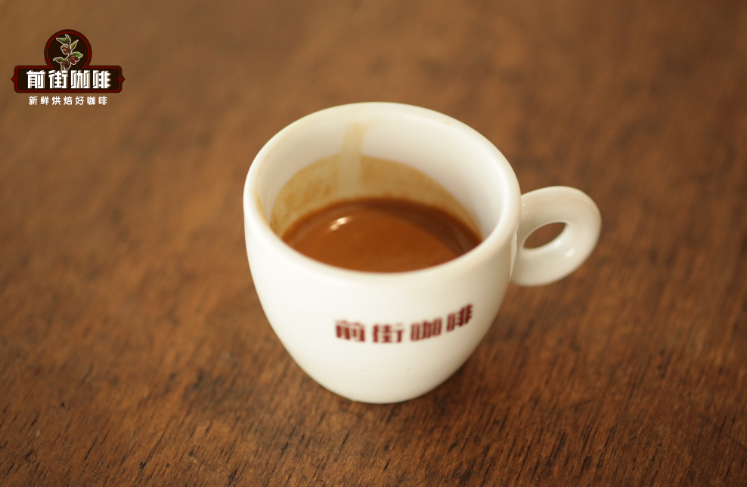
The es of espresso espresso, in fact, is the English ex, which means fast and convenient. Espresso beans are called House Blend, which is commonly heard of as mixed / formulated coffee. As the name implies, they are beans made of mixed beans from multiple producing areas. The use of mixed beans helps to balance the flavor and stabilize the taste. In order to take into account the final brewing quality, we usually use a professional bean grinder to grind the coffee beans to a fine grinding state before making espresso, so that the espresso can be extracted in a short time.
Because the espresso taste is very rich, many people will add sugar or milk to reconcile the bitterness, thus bringing a trend based on espresso. Fancy espresso will be mixed with syrup, cream, spices and other seasonings to create a diverse and layered taste of coffee, such as Campbell blue, macchiato, caramel macchiato, cappuccino, latte, mocha, Italian American coffee. Etc., all belong to the members of the family of Italian coffee!
Espresso is the basic element of many coffee products. Now let's take a look at the common types of espresso.
Espresso (Espresso)
The most common type of espresso is espresso. Espresso uses deeply roasted coffee beans, which flush out the coffee liquid instantly through steam pressure. the coffee tastes strong and bitter, with a deeply roasted charred aroma. it can be said to be the spiritual symbol of the coffee world, and other types of espresso are also derived from espresso. It can be said that if the espresso extraction is not good, other espresso will not taste good.
Espresso Espresso is a fast espresso. When hot water passes through the coffee powder quickly under the action of steam pressure (about 9 atmospheric pressure), the essence of coffee will be fully extracted to complete a cup of rich, aromatic, high-alcohol, bitter coffee with caramel flavor.

Qianjie Coffee is generally based on double espresso (20 grams of coffee powder) to make a cup of about 40 grams of espresso, with a very delicate and rich coffee oil on the surface, also known as "Crema".
American coffee (Americano)
American coffee, which is common in cafes, refers to espresso diluted with a large amount of hot water. it is said that during World War II, the US military who came to Italy was not used to drinking strong espresso, so it was diluted by adding a lot of hot water, and later became another way of drinking espresso.
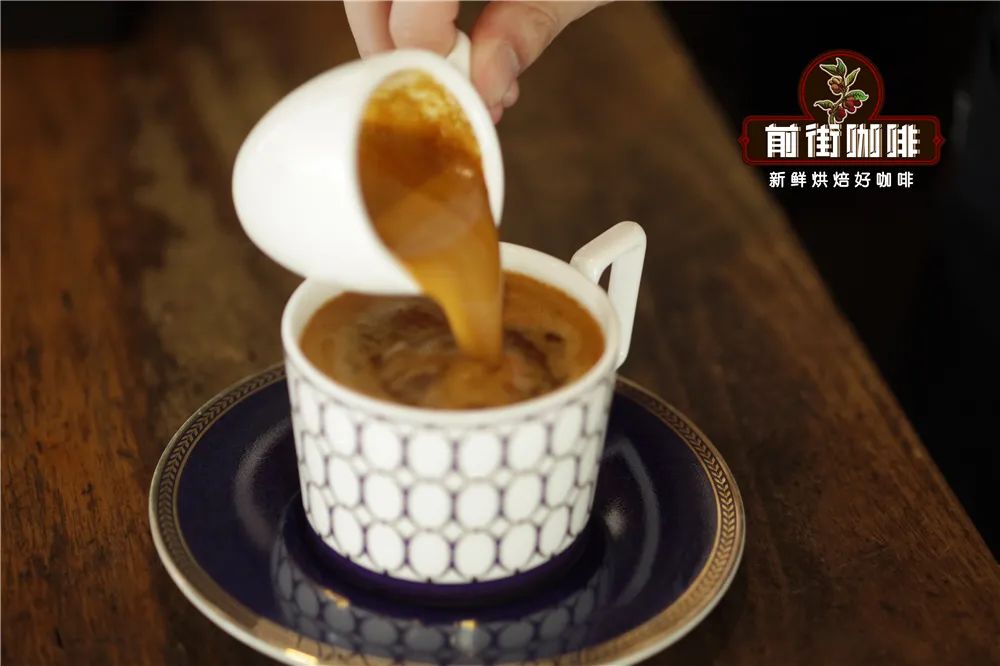
The hot American style of Qianjie Coffee is 40 grams of espresso mixed with 180 milliliters of hot water to get a cup of 220 milliliters of American coffee, with a ratio of espresso to water 1. 5.
Latte (Caffe Latte)
In Italian, latte means milk, while in other places outside Europe, it is an Italian coffee drink with milk and milk foam. The common latte refers to a combination of espresso, hot milk and milk foam. This espresso is full-bodied and can be seasoned with vanilla syrup, cinnamon or caramel. There are different proportions in different areas. In front street, 40g double espresso is used to make latte with 260g milk and milk foam, and the thickness of the milk bubble is 1cm. Of course, lattes can make exquisite flower patterns. The perfect fusion of milk and coffee not only highlights the sweetness of milk, but also reflects the mellow rhyme of coffee.
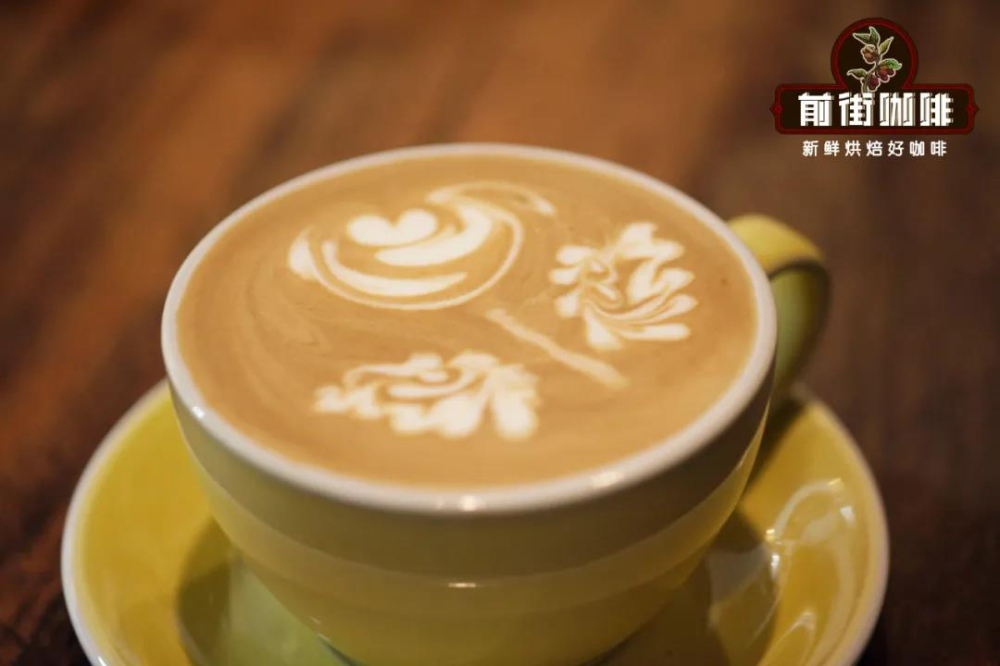
Cappuccino (Cappuccino)
Espresso, milk foam and hot milk are also made up of espresso, milk foam and hot milk. The proportion of coffee is heavier and the taste is stronger. The blended color is similar to that of a Franciscan monk in Italy, so it is named after the Italian monk of St. Franciscan.
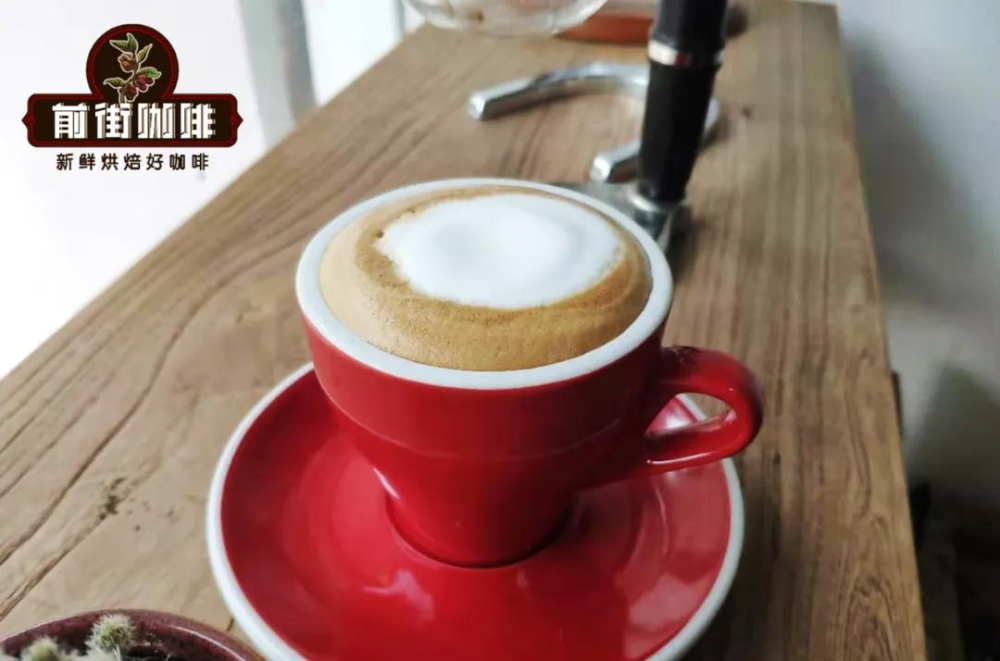
When making cappuccino, Qianjie Coffee chooses to use a 180 ml tulip cup, add one of the espresso that has just been extracted, and then add milk that makes thick milk bubbles.
Moka (Mocha)
Mocha originally refers to a kind of coffee beans with chocolate aroma, but later it generally refers to all kinds of espresso coffee added with chocolate, including espresso with a common proportion of 2max 5, hot chocolate with 2max 5 and hot milk with 1max 5. You can drink the aroma of coffee and chocolate mellow at the same time, and the taste is smooth. Friends who like chocolate drinks can try this espresso.
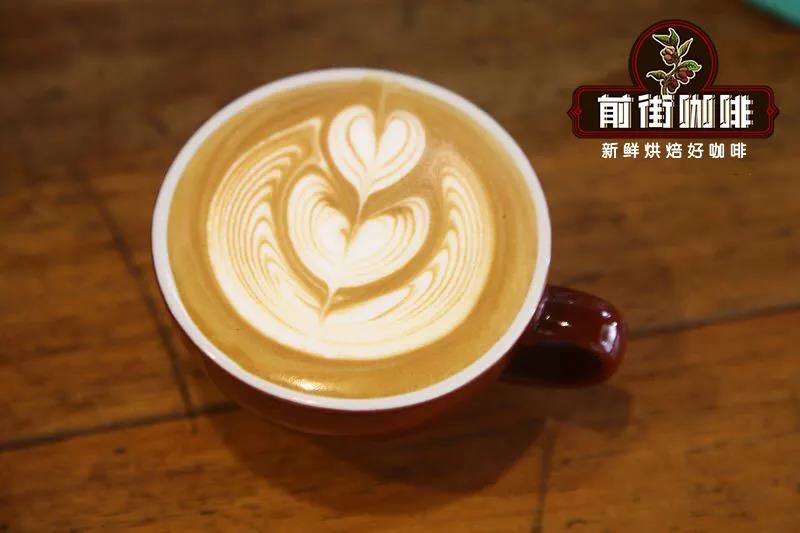
The mocha scheme of Qianjie Coffee is 40g espresso + 20g chocolate sauce + 260g hot milk.
Macchiato Macchiato is an Italian word meaning "marked". Macchiato originated in Italy in the 1980s, when guests were in the habit of adding a small amount of milk to espresso, but the milk soon disappeared from the coffee fat. So the barista wanted to distinguish a plain espresso from an espresso with a small amount of milk, so he "marked" a white spot on the coffee fat with milk. Later, people found that in the gradual integration of milk foam and espresso, they can taste the mellow aroma of espresso and the sweetness of milk, which is intertwined in the mouth. So the traditional macchiato coffee was born.
Qianjie coffee macchiato scheme: 40g espresso + 1 spoonful of delicate milk foam.
Caramel macchiato is Starbucks' star espresso drink (it has nothing to do with macchiato). A medium cup of 355ml coffee contains 1 serving (about 30ml) of espresso (espresso). The other 300ml is milk, vanilla syrup and caramel, which taste sweet.
Caramel macchiato: make it with a lot of milk and foam, not much different from a wet kapok or a thicker latte. With vanilla syrup and slippery hot milk, smooth milk foam, mellow espresso mixed with soft caramel sauce, sweet and mellow caramel macchiato becomes a good choice for coffee lovers to taste espresso.
Dirty Dirty Coffee what do many people think is the difference between Dirty Coffee and iced lattes? Indeed, there are too many similarities between the two, from raw materials to recipes to looks. But if you look closely, you will find that Dirty is essentially a more elegant iced latte. The biggest difference lies in the selection of containers and the operation of details. The containers chosen by Dirty Coffee tend to be glasses that show beautiful liquids, which are ice-free. What is fastidious is that the espresso liquid flows into the white milk, slowly permeates and blends slowly, forming a beautiful layering effect, if with the change of time, the white milk is gradually "contaminated" by the rich Espresso, through the glass, it appears that the drink becomes dirty (dirty). In addition to visual dirt, it also contains the collision between frozen milk and hot concentrate, making people feel the change from heat to ice in a cup of coffee.
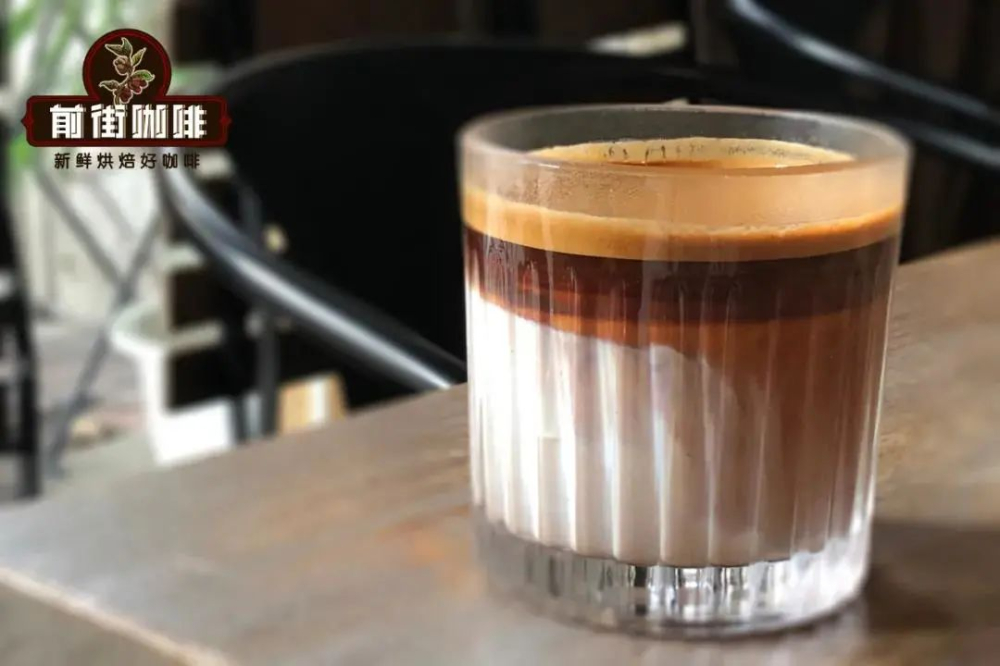
The proportion of Qianjie coffee making Dirty is 150g of milk and 40g of espresso. First of all, take out the pre-chilled glass, make sure there is no water in the glass, and pour in the iced milk. Then buckle the pressed coffee handle and place the glass with iced milk under the shunt (the bottomless handle is directly below the outlet). The outlet should not be too far from the liquid level, if too far, the gravity of the coffee will have a stronger penetration force, easy to "merge", the recommended distance is about 1cm. The flow rate of qualified espresso will flow evenly, slowly into the milk surface, and "float" on the liquid surface, slowly sinking, creating a dirty feeling.
Drink Dirty without stirring, and drink it quickly. You will find that the hot espresso above has not been frozen and the milk below has not been "contaminated". The change from strong chocolate-flavored hot coffee to milk-flavored ice-light coffee is simply wonderful.
Professional coffee knowledge exchange more coffee bean information please follow the coffee workshop (Wechat official account cafe_style) more boutique coffee beans please add private Wechat Qianjie coffee, WeChat: qjcoffeex
Important Notice :
前街咖啡 FrontStreet Coffee has moved to new addredd:
FrontStreet Coffee Address: 315,Donghua East Road,GuangZhou
Tel:020 38364473
- Prev
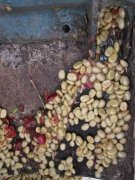
A special coffee bean treatment method, secondary fermentation treatment method
Communication of professional baristas Please follow the coffee workshop (Wechat official account cafe_style) the secondary fermentation method Milky-way Double Soaked is to soak the beans into the fermentation tank twice for 12-24 hours each time. In the two soaks, the beans were fermented and washed by water, leaving no organic matter behind. After the second fermentation, the beans flow through the canal and further separate.
- Next
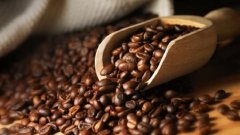
How to determine the freshness of coffee beans? Grasp the three main points: smell, see, and peel!
Professional barista communication please pay attention to the coffee workshop (Wechat official account cafe_style) freshness is the life of coffee, but how to determine the freshness of coffee beans? Grasp the three main points: smell, see, and peel! ◎ smells the coffee beans close to his nose and takes a deep breath to see if he can clearly smell the aroma of the coffee beans. If so, it means the coffee beans are fresh enough; on the contrary
Related
- Beginners will see the "Coffee pull flower" guide!
- What is the difference between ice blog purified milk and ordinary milk coffee?
- Why is the Philippines the largest producer of crops in Liberia?
- For coffee extraction, should the fine powder be retained?
- How does extracted espresso fill pressed powder? How much strength does it take to press the powder?
- How to make jasmine cold extract coffee? Is the jasmine + latte good?
- Will this little toy really make the coffee taste better? How does Lily Drip affect coffee extraction?
- Will the action of slapping the filter cup also affect coffee extraction?
- What's the difference between powder-to-water ratio and powder-to-liquid ratio?
- What is the Ethiopian local species? What does it have to do with Heirloom native species?

